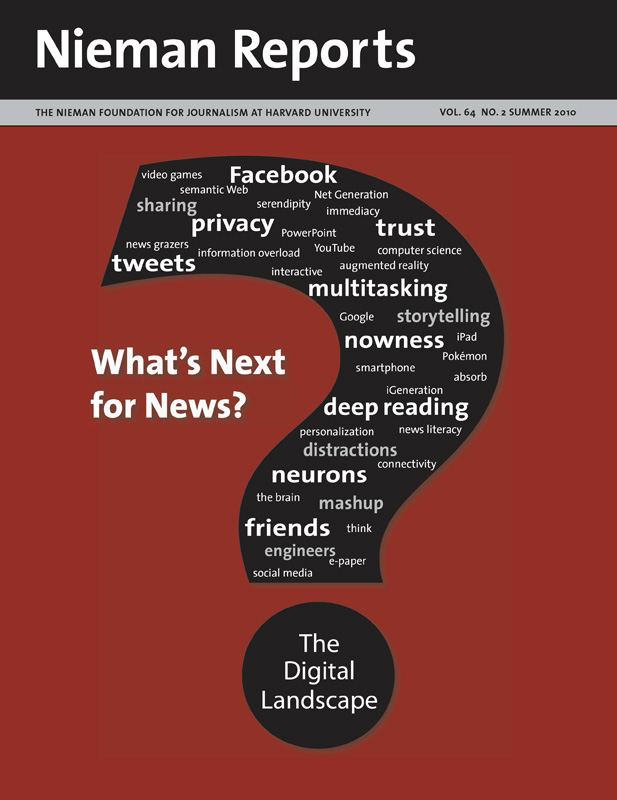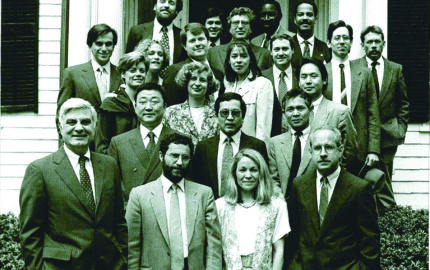For the past nine years, the Nieman Foundation has honored journalistic fairness with the Taylor Family Award for Fairness in Newspapers. Our goal is to encourage fairness and ethical practices in enterprising news coverage by drawing public attention to exemplary work. The award is given in the name of the Taylor family whose stewardship of The Boston Globe over four generations was anchored in the belief of Charles H. Taylor, the first publisher—that in the long run honest and fair dealing will win.
We had no specific definition for “fairness” when the competition began in 2001. To prepare their exhibits for the Taylor award judges, newspapers were asked to explain how stories were framed, reported and presented to readers in the context of fairness. It was our expectation that over time we would build a valuable base of knowledge about what constitutes fairness. A review of the award’s winning entries does, in fact, reveal a range of journalistic practices that have met the test of fairness.
What Makes a Story Fair?
Les Gura of The Hartford Courant received the initial Taylor award for his meticulous account of the badly handled investigation into the murder of a Yale student; a promising young instructor was implicated but never charged. His story forced readers to consider fairness from every angle—by the news media, by the police, by the public, and by a prestigious university. He demonstrated how the Yale teacher’s reputation had been shattered by the use of anonymous sources in other news coverage; he used the words of only those who would go on the record.
In 2003, The Boston Globe was honored for the fairness of its reporting about the sexual abuse scandal in the Catholic Church when it took on a highly sensitive subject in an environment of intense passions. Reporters examined the fact that other denominations had sex abuse scandals of their own, that the victims were not all young boys, that victims’ lawyers were not without blame, and that phony changes against priests constituted a real danger. The Globe also sought to present the story from the perspective of the church and those who worked within it.
Reporter Robin Gaby Fisher and photographer Matt Rainey of The Star-Ledger in Newark, New Jersey won the 2005 award for a report on the lives of students and faculty at a New Jersey school that became known as “Last Chance High.” During the more than 10 months they spent on the story, Fisher and Rainey were able to get close to students, teachers, administrators, parents and drug dealers. Their patient pursuit enabled them to tell a story that was honest but not judgmental, and accurate without romanticizing or denigrating the situation.
A different dimension of fairness emerged in the 2006 coverage by the Lancaster (Penn.) New Era for its series of stories about the shooting of 10 Amish girls in a one-room schoolhouse in rural Pennsylvania. The reporters faced a formidable obstacle: Many in the Amish community did not want their names or photographs published and the state police, out of respect for Amish religious traditions, would not speak for attribution. The solution was to report so exhaustively that the stories could be written confidently and compellingly, shedding light on a world usually hidden from view without revealing the identities of those who wished anonymity.
In 2008, Howard Witt of the Chicago Tribune was recognized for a body of work that focused on three Southern towns where he documented America’s unfinished business of civil rights. Witt’s stories were not simple tales of good and evil. He wrote nuanced accounts of young people with blemished records whose predicaments could be traced to racially unjust legal prosecutions or school discipline meted out in racially disproportionate ways.
The commitment The Charlotte (N.C.) Observer made to fully represent the perspective of a major North Carolina poultry producer was a key factor in the paper winning the 2009 award. The reporters began talking with company officials about health and safety violations nine months before the stories were published. The paper twice postponed publication to allow the company more time to respond to its questions. It posted full written statements from the company on CharlotteObserver.com.
This year, the Chicago Tribune won the award for a second time for an investigation revealing a secret admissions system that enabled children whose parents had political connections to be admitted to the University of Illinois although they did not meet basic academic requirements. The newspaper let university officials speak for themselves at length while protecting the students who had benefitted from the system but were not demonstrably culpable.
Each of these award winners has broadened our understanding of how fairness strengthens the impact and credibility of stories. After nearly a decade, this award affirms our belief that fairness will continue to be recognized in its different manifestations in the years ahead.
We had no specific definition for “fairness” when the competition began in 2001. To prepare their exhibits for the Taylor award judges, newspapers were asked to explain how stories were framed, reported and presented to readers in the context of fairness. It was our expectation that over time we would build a valuable base of knowledge about what constitutes fairness. A review of the award’s winning entries does, in fact, reveal a range of journalistic practices that have met the test of fairness.
What Makes a Story Fair?
Les Gura of The Hartford Courant received the initial Taylor award for his meticulous account of the badly handled investigation into the murder of a Yale student; a promising young instructor was implicated but never charged. His story forced readers to consider fairness from every angle—by the news media, by the police, by the public, and by a prestigious university. He demonstrated how the Yale teacher’s reputation had been shattered by the use of anonymous sources in other news coverage; he used the words of only those who would go on the record.
In 2003, The Boston Globe was honored for the fairness of its reporting about the sexual abuse scandal in the Catholic Church when it took on a highly sensitive subject in an environment of intense passions. Reporters examined the fact that other denominations had sex abuse scandals of their own, that the victims were not all young boys, that victims’ lawyers were not without blame, and that phony changes against priests constituted a real danger. The Globe also sought to present the story from the perspective of the church and those who worked within it.
Reporter Robin Gaby Fisher and photographer Matt Rainey of The Star-Ledger in Newark, New Jersey won the 2005 award for a report on the lives of students and faculty at a New Jersey school that became known as “Last Chance High.” During the more than 10 months they spent on the story, Fisher and Rainey were able to get close to students, teachers, administrators, parents and drug dealers. Their patient pursuit enabled them to tell a story that was honest but not judgmental, and accurate without romanticizing or denigrating the situation.
A different dimension of fairness emerged in the 2006 coverage by the Lancaster (Penn.) New Era for its series of stories about the shooting of 10 Amish girls in a one-room schoolhouse in rural Pennsylvania. The reporters faced a formidable obstacle: Many in the Amish community did not want their names or photographs published and the state police, out of respect for Amish religious traditions, would not speak for attribution. The solution was to report so exhaustively that the stories could be written confidently and compellingly, shedding light on a world usually hidden from view without revealing the identities of those who wished anonymity.
In 2008, Howard Witt of the Chicago Tribune was recognized for a body of work that focused on three Southern towns where he documented America’s unfinished business of civil rights. Witt’s stories were not simple tales of good and evil. He wrote nuanced accounts of young people with blemished records whose predicaments could be traced to racially unjust legal prosecutions or school discipline meted out in racially disproportionate ways.
The commitment The Charlotte (N.C.) Observer made to fully represent the perspective of a major North Carolina poultry producer was a key factor in the paper winning the 2009 award. The reporters began talking with company officials about health and safety violations nine months before the stories were published. The paper twice postponed publication to allow the company more time to respond to its questions. It posted full written statements from the company on CharlotteObserver.com.
This year, the Chicago Tribune won the award for a second time for an investigation revealing a secret admissions system that enabled children whose parents had political connections to be admitted to the University of Illinois although they did not meet basic academic requirements. The newspaper let university officials speak for themselves at length while protecting the students who had benefitted from the system but were not demonstrably culpable.
Each of these award winners has broadened our understanding of how fairness strengthens the impact and credibility of stories. After nearly a decade, this award affirms our belief that fairness will continue to be recognized in its different manifestations in the years ahead.



